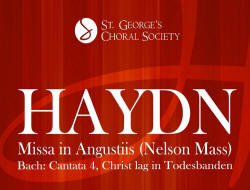 For its annual fall concert, St. George’s Choral Society returns on November 21
to St. George’s Church in New York (7 Rutherford Place, across from Stuyvesant
Square Park) with a dynamic orchestral presentation that pairs Bach’s Cantata 4,
Christ lag in Todesbanden (Christ Lay in the Bonds of Death) and Haydn’s
Missa
in Angustiis (Mass for Troubled Times).
For its annual fall concert, St. George’s Choral Society returns on November 21
to St. George’s Church in New York (7 Rutherford Place, across from Stuyvesant
Square Park) with a dynamic orchestral presentation that pairs Bach’s Cantata 4,
Christ lag in Todesbanden (Christ Lay in the Bonds of Death) and Haydn’s
Missa
in Angustiis (Mass for Troubled Times).
Composed for Easter Sunday, Cantata 4 is one of Bach’s oldest compositions. He wrote the seven-movement piece in his early twenties sometime between 1707 and 1708. Bach would go on to complete hundreds of cantatas throughout his more-than-40-year career as a working church musician, 200 or so of which are extant and display his mastery of the form. Despite the somewhat unremarkable circumstances in which Cantata 4 was conceived -- according to some scholars, Bach completed the cantata as part of his application for a post in Mühlhausen -- it is nonetheless regarded today as one of the composer’s most celebrated sacred works and a prime example of the marriage of art and spiritual insight that the baroque maestro toiled endlessly his entire adult life to achieve.
“Bach is a true master: everything he wrote is a path to the divine,” says Dr. Matthew Lewis, the artistic director and conductor of SGCS. “But, more than the technical perfection, there is a human emotional component. His music speaks to those hearing it as well as the performers. His 4th Cantata is often cited in music history courses as an example of one of his greatest works. It is a concise piece, lasting about 25 minutes. It offers great contrasts from movement to movement, and tells a complete story.”
Narrative cohesion, to say nothing of verve and dramatic resplendence, is also found in one of Haydn’s last completed liturgical works. Known as the Lord Nelson Mass during Haydn’s lifetime, Missa in Angustiis was a wildly popular piece that spoke to the Austrian masses. Haydn, practically a rock star in his time, composed the piece in the summer of 1798 in the small city of Eisenstadt, not far from Vienna, where he was employed by Prince Esterhazy.
Why is the Mass named after the famed British naval hero? Several theories have abounded, but the most plausible one is this: In the year before Haydn put the finishing touches to the mass, Austria had suffered a colossal defeat at the hands of Napoleonic France, which threw the country into a deep malaise. Just as it appeared that Napoleon would go on to conquer Egypt, Horatio Nelson swooped in and thwarted those plans, destroying the French fleet at the Battle of the Nile. Lord Nelson became an instant continental hero. News of the French defeat reached Vienna only after Haydn completed the composition, so it does not seem likely that he had Lord Nelson necessarily in mind to begin with. Instead, the piece probably gained its popular appellation retroactively, specifically after Lord Nelson paid a visit to the Esterhazy Palace, where he was treated to a performance of the Mass. In the minds of the Austrians, the sense of trepidation and optimism conveyed in Missa in Angustiis became synonymous with Nelson’s crucial, clutch heroics.
“The Haydn is, I think, one of his best pieces,” Lewis says. “Singers love to sing it, and instrumentalists love to play it. It also communicates on an accessible level -- thrilling choruses (especially the Kyrie, with its bravura soprano solo), touching solos (the bass "Qui tollis" is one of these) and an exuberant "Dona nobis pacem" (Grant us peace) conclusion.”
So, then, why pair Bach with Haydn? “A lot had to do with orchestration,” Lewis explains. “The Bach is for strings only, and the Haydn is for strings, trumpets and timpani. I thought it would be exciting to move from Bach to Haydn with the addition of these forces. And, the Bach Cantata is sometimes sung by chorus throughout, with the complete chorus sections singing the solo and duet movements. It gives our advanced singers some challenges, and offers another contrast: a smaller chamber ensemble opens the concert with strings, then the full chorus follows with Haydn and more orchestral forces.”
The fall performance marks the first time that SGCS has conducted in-person rehearsals since the onset of the pandemic – a much-welcome return no doubt to some semblance of normalcy. But as Dr. Lewis explains, the digital interactions of the past year have had their own benefits. “We didn't know how good we had it before everything stopped last year,” Lewis says. “We are all very grateful to make music together in an organic way. The only thing that I would say I miss about our online rehearsals was the social component. People, before and after rehearsal, would chat with each other and visit. We do this in person, but we are normally limited to speaking with those immediately around us. Online, we had access to everyone in the group -- they were all right there and visible. I believe we are more social (talking, etc.) than we were in the ‘old days,’ and I believe people made friends and built lasting relationships because of their online experience.”
The soloists include
soprano Sarah Bailey, contralto Heather Petrie, tenor Michael Kuhn and
bass-baritone Enrico Lagasca. You can read more about their backgrounds
here.
The performance will be livestreamed. Tickets are $30
online on the SGCS
website or at the door. In-person tickets purchased online will be held at
the door under the purchaser’s name.
Sean Nam is on the board of the St. George's Choral Society.
